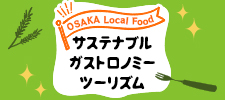
Touring the town where Abe Seimei Shrine is located
Nagai Park is home to Yanmar Stadium Nagai, where many big sporting events have been held. There is also an area in the surrounding area that is lined with Showa-era rowhouses, as the name ``Showa-cho'' suggests. This is the town where Abe Seimei Shrine, which is famous for ``Onmyoji'' and ``Abe Seimei'', is located.
-
START
OSAKA METRO Midosuji Line Nagai Station
-
10minutes WalkNagai Botanical Garden

Nagai Botanical Garden occupies approximately 24.2ha in the southeast corner of Nagai Park. You can enjoy a variety of flowers blooming throughout the year in the park. The mist pouring from the top of the loofah tunnel shown in the photo provides a temporary cooling effect. In addition, there are approximately 1,000 types of trees that attract a variety of wild birds. Adjacent is the Osaka City Museum of Natural History, which provides easy-to-understand explanations of contact with nature and the relationship between humans and plants. I was surprised by the impressive dinosaur models and mammoth replicas at the entrance.
Nagai Botanical Gardensee spot9:30-16:30 (Entry until 16:00)
200 yen for adults, free for junior high school students and younger and those over 65 years of age (limited to Osaka city residents 65 years of age and older)6 minutes walk from Showacho Station on the Osaka Metro Midosuji Line -
Teranishi Family Abeno Nagaya

Just a five-minute walk from Showa-cho Station on the Osaka Metro Midosuji Line, down an alleyway, you'll find the Teranisi Abeno Tenement House, which exudes the atmosphere of the early Showa period. Built in 1933, this two-story wooden tenement house with a tiled hip-and-gable roof and four detached houses is the only one of its kind in Japan designated as a national tangible cultural property. It currently thrives in the town as a gallery and Japanese, Western and Chinese restaurants. Dining in a room built before the war will bring back memories of the past, and fill you with nostalgia.
see spot20 minutes walk -
Abe Seimei Shrine

A 20-minute walk from Teranishiya Abeno Nagaya is the shrine of ``Abe no Seimei,'' said to be the strongest onmyoji. Abe Seimei Shrine is also the birthplace of fortune-telling, as it enshrines Abe Seimei, an onmyoji who became widely known throughout the world due to the ``Onmyoji'' and ``Abe Seimei'' crazes that were made into novels, manga, movies, and TV dramas. The daily fortune-telling corner held on the grounds is also very popular! ! Also, there is Seimei water labeled as ``drinkable water'' on the grounds, so be sure to try it.
see spotA short walk -
Abe Oji Shrine

Abe Oji Shrine is located 50m south of Abe Seimei Shrine. The company is believed to have benefits such as warding off evil spirits, good health, and healing from illness. There are three camphor trees on the grounds that are designated as preserved trees by Osaka Prefecture. In front of the main shrine, there is an illustrated guide that says ``How to worship: Two bows, two beats, one bow.'' Let's follow the instructions and visit the shrine in the official way. After visiting the shrine, why not try your luck and see if your wish will come true right away? The fortunes here are also written in English, so it's also recommended for foreigners!
see spot -
Hankai Electric Tramway (Chin Chin Train)

If you want to experience Osaka as it is, we recommend Hankai Electric Railway. Osaka has a strong image of being impatient, but this area has nostalgic scenery that makes you feel as if time has stopped, and the pleasant sway of the trains as they slowly move through them, making you feel at ease.
see spotImmediately after getting off at Hankai Electric Tramway Sumiyoshi Torii-mae Station -
Sumiyoshi Taisha Shrine

After a 16-minute journey from Tennoji Station on the Hankai Electric Tramway to Sumiyoshi Torii Station, you will arrive at Sumiyoshi Taisha, the head shrine of the 2,300 or so Sumiyoshi shrines across the country. This is the most popular shrine for New Year's visits in Osaka. The main hall is divided into four, and Sokotsutsuo no Mikoto is the god enshrined in the first main hall. The Soribashi Bridge, over 260 large and small stone lanterns, and the Sumiyoshi Jindaiki, which are located within the shrine grounds, are designated cultural properties. There are over 20 auxiliary and subordinate shrines, and many festivals and events are held, such as the Natsugoshi Festival. Walking around the grounds of Sumiyoshi Taisha will put your heart at ease. Here too, you should follow the formal procedures for praying. The main shrine's charms and love fortune-telling slips are also very popular!!
see spot - GOAL!












